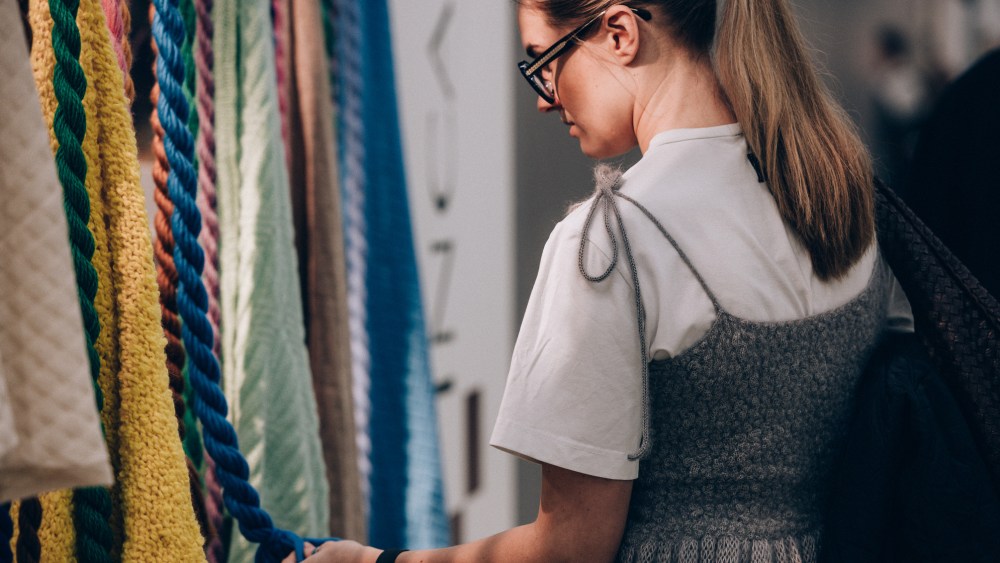MILAN — The fashion industry is grappling with the economic headwinds and geopolitical turmoil denting consumer confidence and the supply chain is feeling the pinch of slower demand, with little to no visibility even on short-term prospects.
Yarn-makers at the top of the fashion pipeline are playing it by ear, as 2024 registered a mixed performance for many and 2025 has not opened on more positive notes.
The global turmoil imposes caution and for companies to embrace a wait-and-see mode.
You May Also Like
“Every sector is facing big challenges and especially the lack of planning and overall pessimism prevent us from making evaluations on the second half of the year,” said Alberto Enoch, chief executive officer of silk-maker Servizi e Seta.
Alberto Corti, owner of spinning company Monticolor, shared a similar view. “Business models and [brand] strategies are constantly changing as a result of extreme uncertainty and market volatility,” he said. In 2024 the company logged 30 million euros in sales, in line with the previous year, but Corti expects a moderate drop this year.
According to data provided by Confindustria Moda, revenues of the Italian spinning industry decreased 9.8 percent in 2024 to 2.6 billion euros, below an earlier consensus pointing to a 6.2 percent drop. Exports declined 9.4 percent to 786 million euros.
In the first quarter of 2025, sales have dropped 8 percent and exports were down 10.8 percent, according to preliminary estimates.
The 130 companies gathering at the three-day textile trade fair Pitti Filati, starting Tuesday, will get a sense of where business is headed for the remainder of the year. Unveiling their fall 2026 collections, hinged on timeless yarns done in a reassuring color palette, they are hoping for a rebound of the luxury and fashion sectors, at least in 2026.
“The landscape against which 2025 has opened, especially the war in the Middle East, is not contributing to market stability,” Enoch said, mentioning increasing prices for energy and raw materials which suppliers have a hard time absorbing, especially as fashion players are pushing back on investments.

Earlier this year the silk specialist was acquired by Filidarte Group, a textile group promoted by Ethica Global Investments and already the owner of Lanificio dell’Olivo and Manifattura Sesia. Enoch — who has retained his CEO role — expects the integration to favor competitiveness. In 2024 Servizi e Seta generated a turnover of 25.3 million euros, up 6 percent compared to the previous year and sales in the first half of 2025 are pointing to a midsingle-digit growth.
“The breakdown of global power balances and the return of strategic rivalry between major powers are driving a major rethink of long-established paradigms and worldviews — once solid, now increasingly unable to keep pace with global change,” said Lincoln Germanetti, president of Filatura di Tollegno 1900.
Declining to provide 2024 sales or figures for the first half of this year, Germanetti said business performance is substantially in line for the latter period.
“The generalized sense on instability is negatively impacting consumer confidence and willingness to spend,” said Lorenzo Piacentini, CEO of wool mill Zegna Baruffa Lane Borgosesia.
In 2024 the brand’s revenues declined 16 percent to 74 million euros, a drop that Piacentini attributed to luxury’s retail slowdown, stagnation of some markets, including China, and overstock across the supply chain from the previous euphoric years.
“Despite the persistent geopolitical uncertainty and slowdown of international spending, the first half registered higher sale volumes compared to the same period in 2024, confirming a promising restart, related essentially to the quality of our product offering and services, which favors loyalty and strengthens our market shares with key clients,” Piacentini said.
At Biella, Italy-based wool mill Botto Giuseppe, CEO Silvio Botto was equally concerned about the many global issues factoring in.
On the heels of a moderate slowdown in sales last year, which fell 4 percent versus 2023, the executive said 2025 has not opened on a more positive note. “I’m convinced that the ongoing wars and rising inflation in certain markets have dented consumer confidence,” he said.

“In such a context, one needs to assess and seize the opportunities that the market may present you, riding the positive trends with readiness to change,” Enoch said.
The industry is under further threat posed by the uncertainty over the outcome of tariff negotiations between the Trump administration and international countries.
Textile executives sounded particularly cautious in expressing their views.
“I don’t have a clear understanding of the economic policy in the U.S.,” Corti said. “Our commercial relationships with brands that have a strong footprint in the U.S. is ongoing.…Our operative strategies take into careful account the dynamics in this market,” he said.
Enoch expressed perplexity over the rationale behind the tariff policy, which he views as unlikely to reboot the U.S. fashion supply chain. European and Chinese manufacturing will continue to rule the fashion pipeline, he said.
According to Piacentini, the most tangible impact of the tariff policy is the uncertainty it generates, for the measures place the international textile supply chain in standby mode, he said.
None of these companies has been skimping on advancing their production capabilities and sustainability credentials, though, readying for a bounce back of the sector.
“We are already seeing a certain attitude toward valuing the quality of products, which is bound to favor the high-end, sustainable and traceable offering,” said Piacentini, adding that the company has recently joined industry association SlowFiber. “To this end, Zegna Baruffa Lane Borgosesia and more generally the value of Made in Italy manufacturing should emerge as winners from the unsettling challenges of our time,” he said.
Overall, the fall 2026 collections to be presented at the fair hinge on classics, with a chic and timeless allure with a tactile and cocooning quality. This suggests spinners are playing it safe in times of uncertainty and leveraging their carryover textile products to ensure a better and speedier service to their clients.
Cashmere reigns supreme, oftentimes seen in blends with lighter threads, such as Monticolor’s Nordic Sense and Arctic Sense, both including OCS-certified organic cotton fibers, giving an iridescent finish. The luxurious fiber is enriched by silver microsequins in Monticolor’s Twinkle Sense or steel threads in Botto Giuseppe’s Flair Steel yarn, boasting a metallic shimmer.

At Zegna Baruffa Lane Borgosesia, cashmere was blended in with ultrafine, 17.5-micron merino wool for the Neo Millennium yarn or the Eclair carded option, which boasts the same softness as full cashmere threads. With Mirage, the mill is pushing the innovation envelope as the yarn combines RWS-certified merino wool and Spiber’s Brewed Protein fiber.
Elsewhere, the Biella, Italy-based yarn maker zeroes in on its hero Cashwool merino wool yarns, offered for fall 2026 in new iterations with enhanced softness and lightness or neatness.
More merino wool iterations include Botto Giuseppe’s American Wool Tec, sourced from the Shaniko farms in Oregon which have adopted the Carbon Initiative for regenerative agriculture, or Tollegno 1900’s Marley bouclé and Monticolor’s RWS-certified, speckled Polar Merino yarn.

The latter taps into the ongoing chunky, crafty knit trend, as do Botto Giuseppe’s Flair and Flair Brush full cashmere threads, defined by a soft, cocooning touch and silky finish; Tollegno 1900’s Country, a blend of the RWS-certified Pure New Wool yarn with hemp giving a tactile, rough feel, and Servizi e Seta’s Puhjio, a blend of baby llama and polyamide.
Loro Piana’s Wish Onde Soft also boasts exceptional softness and hairiness, while the new Wish Rice part of the same family is a fancy yarn defined by a rugged, tactile effect ensured by chain-like structure.

Sophisticated tweeds stand out in the Monticolor fall collection with Tweed Sense, combining cashmere and cotton spun according to the jaspé technique, in Botto Giuseppe’s range, with the Cashtweed Mouliné yarn, and in Loro Piana’s lineup with the RWS-certified Falkland Boucle, defined by a nubbier effect.
The Woolmark Company is to spotlight the trademarked QuantumColour technology by start-up Colourizd at the fair. The alternative dyeing process is based on the injection of colored pigments that tie to the thread and requires the use of only half a liter of water for each kilogram of yarn.



